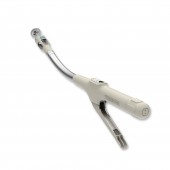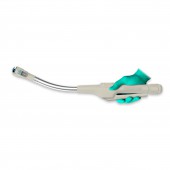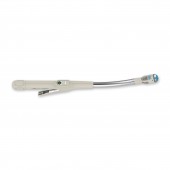CST Platform Circular Stapler by Lane Foo |
Home > Winners > #93518 |
 |
|
||||
| DESIGN DETAILS | |||||
| DESIGN NAME: CST Platform PRIMARY FUNCTION: Circular Stapler INSPIRATION: Surgical staples for internal use are medical devices used to deliver compatible staples to internal tissues during surgery. In 1978, the first circular stapler was invented, mainly used in gastrointestinal, gynecological, and thoracic surgery. More than 15 million surgical procedures were done with staplers in 2018 with an increasing rate of 7.2% year by year. For more than 40 years, no breakthrough development of circular staplers’ structure and performance. Problems such as the limited volume of the tubular casing and poor consistency of staple formation have plagued surgeons and manufacturers. In the United States only, annual adverse events due to staples malformation accounted for 32.1% of the overall reports, and almost 1% of patients died accordingly. According to our research,the malformation is caused by the piston effect in the head part of circular stapler. It will challenge us to rethink and redefine what is possible and how we can improve circular staplers to our surgeons and benefit to patients. UNIQUE PROPERTIES / PROJECT DESCRIPTION: The most important thing that surgeons can focus on their patients and the life-saving procedures. Medical devices can help surgeons achieve their goals. CST platform is an advanced circular stapler platform. A build-in barrier-free structure helps to solve the problem of malformation which caused by the piston effect. Engineer removed the problem maker—internal supporting structure, increased the head volume, to get flat and even tissue condition. This will ensure the tissue won’t milk out from the head part of circular stapler while it is fired. Safety lock of a circular stapler plays an important role in the surgery. When the indicator is not fully within the green range while tissue is being compressed, attempting to fire may cause a disaster. After firing, re-squeeze the firing handle will also damage the anastomosis ring. That’s why all other circular stapler set a manual safety lock to avoid problems. Nonetheless, surgeons forget to release or reset the safety lock that still occurs. The designer created the 4th generation automatic safety lock. It is smart, will engage driven members only when the instrument is in the correct firing status. This solves problems fundamentally. CST platform also provides audible feedback to remind the surgeon that she/he has completed the firing successfully. OPERATION / FLOW / INTERACTION: CST platform is used in digestive surgery. It has the same indication as the conventional circular stapler. The main difference is product performance and user experience. The most clinical benefit of CST platform is that with barrier-free, the occurrence of surgical leakage caused by staple malformation, which is the severe postoperative complication, will decrease remarkably. Thanks to the enlarged volume of the tubular casing, now with one CST stapler,the surgeon is able to resect the amount of tissue in which conventionally needs two. This helps to reduce the cost of medical treatment for patients. With the adoption of the 4th generation automatic safety lock, it changes the complicated operation of instruments into simple, shortens the learning curve of surgeons, let them concentrate on the surgery itself. PROJECT DURATION AND LOCATION: Nearly eleven years in development, the project began in January 2008 and released in Suzhou, Milano, New York, and Sydney in August 2018. FITS BEST INTO CATEGORY: Medical Devices and Medical Equipment Design |
PRODUCTION / REALIZATION TECHNOLOGY: We care about all aspects of product experience. We hope that during the firing, the surgeon can not only feel but also hear the feedback from the device. A clear and distinctive bell tone can be heard after firing, which reminds surgeon to avoid re-squeeze the firing trigger. It increases the safety level of an operation. SPECIFICATIONS / TECHNICAL PROPERTIES: Product dimensions differs in different models. General dimension, height: 501mm, width: 186mm, depth: 34.5mm. Weight: 470g. Firing force: nearly 200N e.g. CST29: the diameter of the stapler housing is 29mm, the volume of tubular casing is 13.2 cubic millimeter, the area of opening windows: 1332 square millimeter TAGS: Medical device, Surgery, Surgical stapler, Circular stapler, Anastomosis, Barrier-Free, Piston effect, Leverage-Control, Automatic safety lock RESEARCH ABSTRACT: To provide excellent products, engineers had analyzed the main technical indicators such as the stress analysis of the core components, staple formation, etc. While the instrument is being closed, the head part has to bear up to 90kgf force to compress the tissue. During the firing, it needs another 48kgf force to cut through the washer and 50kgf force to ensure proper staple formation. We have reinforced the structure of the stressed components and selected heavy strength materials to bear the huge force. The yaw of the anvil is a very important index, which directly affects whether the staple leg can be aligned with the forming notch or not. Engineers designed a yaw test scheme: apply 10kgf lateral force to the anvil to measure its yaw. In this test, the actual swing of CST is less than 0.2 mm, which is 60% less than the average value 0.53mm. CHALLENGE: Engineer should be balanced by many factors, such as process, material, cost, etc. Engineering validation brings us the great challenges to remove the support structure of stapler housing, the rigidity of the tubular casing is reduced to cause the yaw of the anvil. Engineers work on design, materials, and processes to resolve this contradiction. Firstly, improve the design. After removing the support structure, engineers insert a stainless steel sleeve in the anti-expansion tube to reduce the gap between the anvil shaft and the anti-expansion tube, increase the precision and coaxial. Secondly, search for higher strength and biosafety materials to meet new design demands. Thirdly, in terms of processing and manufacturing processes, machining accuracy must reach the micron level to meet our design expectations. Nonetheless, higher design standards and assembly accuracy have also brought huge challenges to the product percent of pass and cost. ADDED DATE: 2019-10-11 06:27:53 TEAM MEMBERS (2) : Designer:Lane Foo, and Engineer:Terry Lin, Alex Guo, Chris Chen, Jackel Ding, Tom Liu IMAGE CREDITS: Lane Foo, 2019. PATENTS/COPYRIGHTS: Patent No.: PCT/CN2018/121973, PCT/CN2018/120698, PCT/CN2018/120697, PCT/CN2018/118111, PCT/CN2018/120699, PCT/CN2018/122049, PCT/CN2018/120122 CN201711434954.3, CN201711431490.0, CN201711434138.2, CN201711435672.5, CN201711435644.3, CN201711434086.9, CN201711451948.9, CN201711472884.0, CN201711473924.3, CN201711473925.8, CN201711478115.1, CN201711472892.5, CN201711473891.2 |
||||
| Visit the following page to learn more: https://www.touchstone.hk | |||||
| AWARD DETAILS | |
 |
Cst Platform Circular Stapler by Lane Foo is Winner in Medical Devices and Medical Equipment Design Category, 2019 - 2020.· Read the interview with designer Lane Foo for design CST Platform here.· Press Members: Login or Register to request an exclusive interview with Lane Foo. · Click here to register inorder to view the profile and other works by Lane Foo. |
| SOCIAL |
| + Add to Likes / Favorites | Send to My Email | Comment | Testimonials | View Press-Release | Press Kit |
Did you like Lane Foo's Medical Product Design?
You will most likely enjoy other award winning medical product design as well.
Click here to view more Award Winning Medical Product Design.








